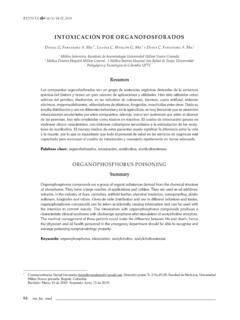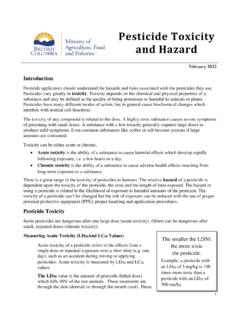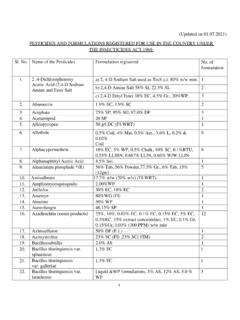Transcription of Orchid Pests and Diseases Diagnosis, Treatment and Prevention
1 Orchid Pests and DiseasesDiagnosis, Treatment and Preventionby Sue Bottom, Orchid Pests Plant Sap Feeding Insects Scale Mealybugs Aphids Thrips Whiteflies Spider Mites Chewing Pests Snails and Slugs Caterpillars Roaches and GrasshoppersSymptoms and Treatment of Sap Feeding InsectsScaleSymptoms: Scale are sucking insects that attach to and feed on the underside of leaves, in leaf axils, on pseudobulbs and on rhizomes. They often are hidden under old leaves and pseudobulb sheaths. Severe infestations cause chlorotic areas to appear on the leaves and plant surfaces which will yellow and may darken and can cause the leaf to drop : If there are only a few scale, use a Q tip dipped in isopropyl alcohol or toothbrush dipped in a pesticide like malathion , Orthene or Safer Soap (used per label instructions) to physically remove scale.
2 For more severe infestations, apply the pesticide at the crawler stage and repeat the application 2 weeks later. Be sure to spray all plant surfaces, particularly the undersides of leaves and leaf : Remove old leaf and flower sheaths to eliminate scale hiding places and allow easy inspection. Check new plants carefully before adding to the growing and Treatment of Sap Feeding Insects MealybugsSymptoms: Mealybugs are sucking insects that attack any part of the plant but tend to stay tucked away at the junction of leaf and stem.
3 Severe infestations cause chlorotic areas to appear on the leaves, which may darken, causing the leaf to yellow and drop : If there are only a few mealybugs, use a Q tip dipped in isopropyl alcohol or toothbrush dipped in a pesticide like malathion , Orthene or Safer Soap (used per label instructions) to physically remove the mealybugs. For more severe infestations, apply the pesticide and repeat the application 2 weeks later. Be sure to spray all plant surfaces, particularly the undersides of leaves and leaf : Remove old leaf and flower sheaths to eliminate hiding places and allow easy inspection.
4 Check new plants carefully before adding to the growing and Treatment of Sap Feeding Insects AphidsSymptoms: Aphids are sucking insects that attack buds, flowers and new growths and transmit disease from plant to plant. Buds and flower may fail to open and leaves may have a sticky : Wash aphids away from the plant with a jet of water. Plants can be sprayed with a pesticide like malathion , Orthene or Safer Soap using the product in accordance with label instructions. Miscellaneous: The honeydew excreted by aphids and other sucking insects is attractive to ants and is an ideal medium for sooty mold.
5 When sooty mold is present, inspect the plants for aphids, mealybugs, scale and courtesy of the American Orchid SocietySymptoms and Treatment of Sap Feeding InsectsThripsSymptoms: Thrips are very small sucking insects that feed on flowers and occasionally leaves and can transmit disease from plant to plant. Infested buds may not open and flowers may be deformed exhibiting water soaked spots. Leaves may appear pitted, stippled, silvery or : Plants and flowers can be sprayed with a pesticide like Orthene, malathion or Safer Soap, applied in accordance with label instructions.
6 Repeat applications will be required because thripsremain hidden on the plant or can be reintroduced to the plant from other flowers in the landscape. Control: Good sanitation will help prevent infestation as will keeping plant hosts (flowers, citrus, gardenias, eucalyptus, etc.) separate from your orchids. Symptoms and Treatment of Sap Feeding InsectsWhitefliesSymptoms: Whiteflies are small, moth-like insects that attack buds, flowers and new growth. The tell tale sign of whiteflies is a cloud of tiny white insects arising from an affected plant when it is moved or disturbed.
7 Treatment : Plants can be sprayed with malathion , Orthene or Safer Soap following label instructions. Repeat applications at 4 day intervals until whiteflies are no longer present. Control: Good sanitation and elimination of weeds will help prevent infestation as will keeping plant hosts separate from your orchids. bottom picture courtesy of the American Orchid SocietySymptoms and Treatment Spider MitesSymptoms: Mites are not insects, they are members of the arachnid family. Mites typically feed on the underside of the leaves and can be found under the leaves as small, red to brown Pests .
8 A hand lens may be needed to see them. Leaf undersides may have webbing and brown splotches from the mite excrement. The upper surface of a damaged leaf may have a silvery sheen that eventually becomes sunken and turns brown. Leaves may be streaked, stippled or spotted due to lack of chlorophyll. Treatment : Plants can be sprayed with a miticide like Kelthane following label instructions being particularly careful to contact all the undersides of the leaves. During warm weather, new generations mature every 6 days so repeat applications will be required, perhaps 3 applications at 4 day intervals.
9 Prevention : Mites appear during warm, dry weather. Increasing humidity and leaf wetness and, if possible, decreasing temperature help prevent bottom pictures courtesy of the American Orchid SocietySymptoms and Treatment of Chewing PestsSnails and SlugsSymptoms: These mollusks will leave holes and notches in the leaves, flowers roots and may chew off the growing tips. Chewed areas may also appear on buds. These nocturnal Pests travel on a layer of slime and this slime trail is evidence of their : Chemical baits may be placed in the growing area.
10 Ash and diatomaceous earth can be spread on horizontal surfaces to create a barrier though water will deactivate it. Beer in shallow tins can be spread in the growing area and the drowned Pests removed the next day. Regular applications will have to be used because watering will disperse the controls. bottom pictures courtesy of the American Orchid SocietySymptoms and Treatment of Chewing PestsCaterpillarsSymptoms: Caterpillars are the immature stage of moths and butterflies. While not common, they are voracious feeders that can do a great deal of damage to flowers and leaves in a short period of : Caterpillars can be physically picked off the plant and destroyed, check the underside of leaves for their presence.


